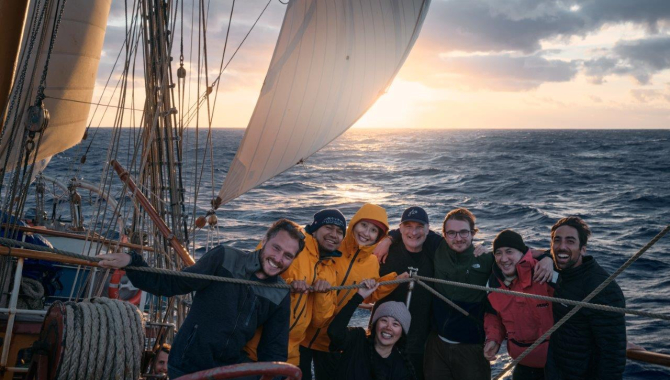The fair Southeasterlies keep blowing, we follow them close hauled on a good day of sailing towards Namibia

A day for great sailing, sunny weather, and a Southeasterly that just comes up and down a bit, now turns a bit more south, now a bit more east. We follow it sailing close-hauled. But the ship drifts north with this wind plus quite a lot of current, making it difficult to keep a course to make some way to close-up with the African coast.
At the compass on the wheel we try to steer around the 90º, our course over ground is just over 50º.
To avoid more leeway, reduce a bit the speed on a direction that is bringing us northwards and not closer enough to land as intended, in the afternoon, under stronger wind puffs, Royals and Outer Jib are doused and packed away.
Sails are up, braces are set on close hauled, and we just had this much of sail handling going on since we caught this steadier wind. Nevertheless the work doesn’t stop here:
Their trim is quite important too, to hook into the wind properly. A crease on a sail to be stretched, a sheet to be pulled tighter, a halyard to haul better.
On deck, there are always wooden blocks to be overhauled, sanded, varnished, and readied to be replaced aloft. Some painting jobs are on during the good weather days, and some lines and wires are to be prepared to replace old ones. Cleaning cabins, toilets, and common spaces is a job that must be taken care of as well. Not to mention the always busy galley preparing their tasty meals.
“Aren’t sailors very idle at sea? - What can they find to do?”
This is a very natural mistake, and being very frequently made, it is one which every sailor feels interested in having corrected. In the first place, then, the discipline of the ship requires every man to be at work upon something when he is on deck.
You will never see a man, on board a well-ordered vessel, standing down or leaning over the side. It is the officer’s duty to keep every one at work.
With regard to the work upon which the men are put, it is a matter which probably would not be understood by one who has not been at sea.
When I first left the port and found that we were kept regularly employed for a week or two, I supposed that we were getting the vessel into sea trim, and that it would soon be over, and we should have nothing to do but to sail the ship, but I found that it continued for two years, at the end of which there was as much to be done as ever. As has often been said, a ship is like a lady’s watch, always out of repair.
Richard Henry Dana. Two Years Before the Mast. 1840
The ship and the sailors have their own jargon, different from the landlubber’s talk, of which we soon get acquainted with its basics. On occasions it seems like a sailor’s secret code, whilst in others some of it is fairly easy. Lines to haul; sheets and halyards; port and starboard instead of left and right. Brace doesn’t mean “brace yourself” but pull on the rope to change the angle of the yards. We splice lines or wires; we worm and parcel cables; we strop and seize grommets for the hundreds of blocks that run on the rig.
These cleaning and those maintenance tasks, amongst others, run in parallel to the other duties during the watch: Lookouts, steering, bracing, furling, unfurling, setting sail, hauling halyards, sheets, or downhauls.
If you show a real interest in learning about sailing and classic navigation techniques. Or you are curious about sail handling, talks, and lectures about a variety of subjects that are offered daily aboard. Maybe you will learn to enjoy doing repairs. Or you want to soak into the ship’s life, not just relegating your duties to the minimum expected. You could add also giving a hand on the doings of the busy crew and the upkeeping of a fairly traditional rig and a steel hull already 114 years old.
If so, there is no time to get bored or for a question such as “Aren’t sailors very idle at sea? - what can they find to do?”



